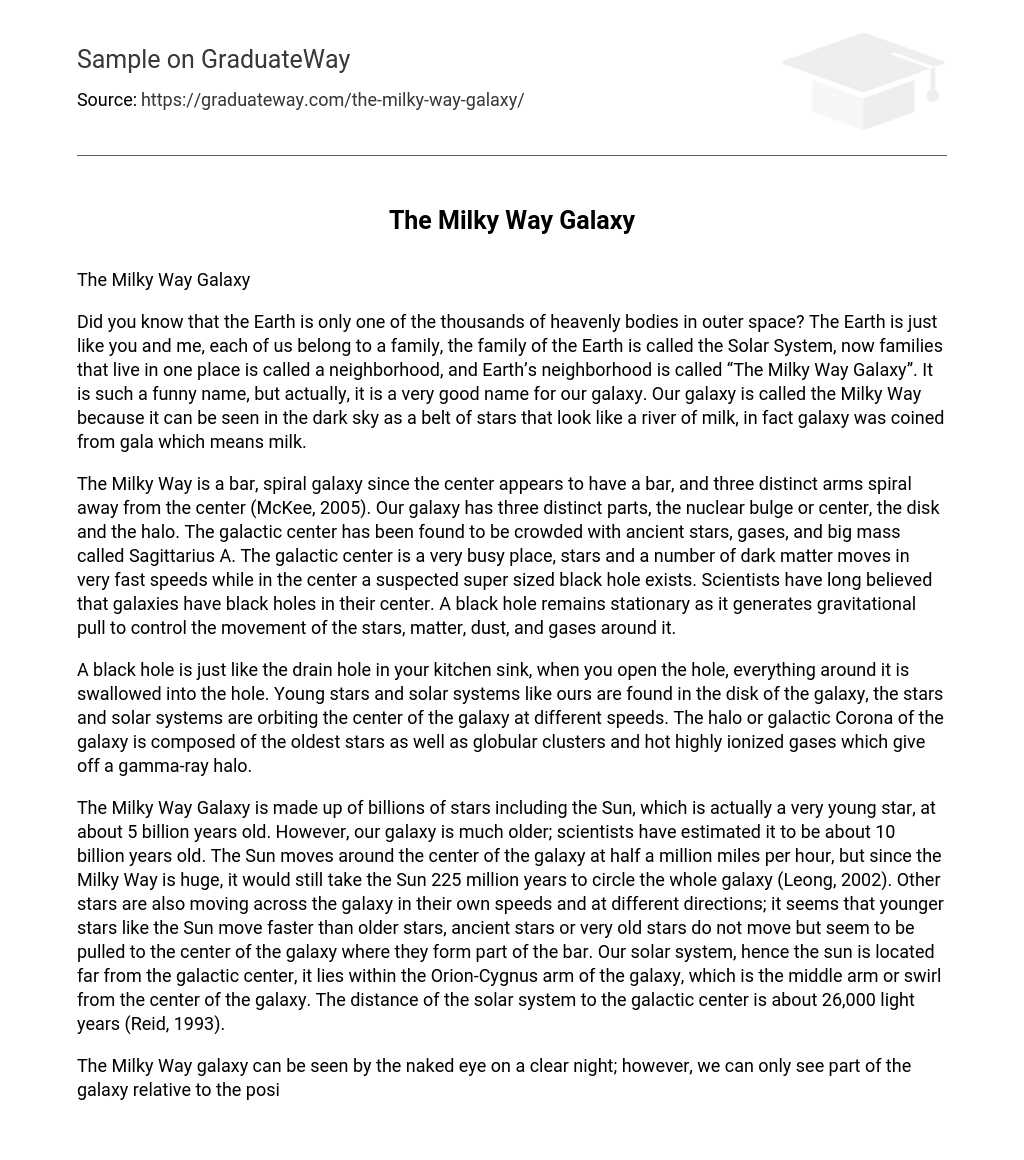Did you know that the Earth is only one of the thousands of heavenly bodies in outer space? The Earth is just like you and me, each of us belong to a family, the family of the Earth is called the Solar System, now families that live in one place is called a neighborhood, and Earth’s neighborhood is called “The Milky Way Galaxy”. It is such a funny name, but actually, it is a very good name for our galaxy. Our galaxy is called the Milky Way because it can be seen in the dark sky as a belt of stars that look like a river of milk, in fact galaxy was coined from gala which means milk.
The Milky Way is a bar, spiral galaxy since the center appears to have a bar, and three distinct arms spiral away from the center (McKee, 2005). Our galaxy has three distinct parts, the nuclear bulge or center, the disk and the halo. The galactic center has been found to be crowded with ancient stars, gases, and big mass called Sagittarius A. The galactic center is a very busy place, stars and a number of dark matter moves in very fast speeds while in the center a suspected super sized black hole exists. Scientists have long believed that galaxies have black holes in their center. A black hole remains stationary as it generates gravitational pull to control the movement of the stars, matter, dust, and gases around it.
A black hole is just like the drain hole in your kitchen sink, when you open the hole, everything around it is swallowed into the hole. Young stars and solar systems like ours are found in the disk of the galaxy, the stars and solar systems are orbiting the center of the galaxy at different speeds. The halo or galactic Corona of the galaxy is composed of the oldest stars as well as globular clusters and hot highly ionized gases which give off a gamma-ray halo.
The Milky Way Galaxy is made up of billions of stars including the Sun, which is actually a very young star, at about 5 billion years old. However, our galaxy is much older; scientists have estimated it to be about 10 billion years old. The Sun moves around the center of the galaxy at half a million miles per hour, but since the Milky Way is huge, it would still take the Sun 225 million years to circle the whole galaxy (Leong, 2002). Other stars are also moving across the galaxy in their own speeds and at different directions; it seems that younger stars like the Sun move faster than older stars, ancient stars or very old stars do not move but seem to be pulled to the center of the galaxy where they form part of the bar. Our solar system, hence the sun is located far from the galactic center, it lies within the Orion-Cygnus arm of the galaxy, which is the middle arm or swirl from the center of the galaxy. The distance of the solar system to the galactic center is about 26,000 light years (Reid, 1993).
The Milky Way galaxy can be seen by the naked eye on a clear night; however, we can only see part of the galaxy relative to the position of the Earth and not its entirety. On a dark night usually when there is still a new moon, and there is no fog or bright lights from the city, we can see the Milky Way right in the sky, we just have to look for a large band of stars. However, if we want to see the center of the galaxy where it is the brightest part of the galaxy, we need to look for the constellation Sagittarius; the galactic center can be found passing through Sagittarius (Smith, 1999). The best time to see the center of the galaxy is during the summer evenings in the Northern Hemisphere or on a winter evening in the Southern Hemisphere since the galactic center would be at its highest point above the horizon.
On the other hand, we cannot see much details of the galactic center without the use of special equipments since the earth is on the disk of the galaxy, dust particles prevent us from seeing the center of the galaxy. Also we cannot see it with visible light since the galaxy have very little surface light, any source of light or light pollution tend to obscure the galaxy from the naked eyes (Smith, 1999). This is why; scientists and astronomers use radio and infrared to get a clearer picture of the galaxy in visible light. The more detailed pictures would help us understand the shape and the composition of the galaxy. If we could see the center of the galaxy, it would be a very bright mass of matter and would appear to be exploding and moving in different directions, which is a very frightening sight.
References
Leong, Stacy (2002). “Period of the Sun’s Orbit around the Galaxy (Cosmic Year)”. The Physics
Factbook. Retrieved on October 22, 2008.
McKee, Maggie (August 16, 2005). “Bar at Milky Way’s heart revealed”, New Scientist.
Retrieved on October 22, 2008.
Reid, Mark J. (1993). “The distance to the center of the Galaxy”. Annual review of astronomy
and astrophysics 31: 345–372. doi:10.1146/annurev.aa.31.090193.002021. Retrieved on October 22, 2008.
Smith, Gene (1999). “The structure of The Milky Way”. University of California Center for
Astrophysics & Space Sciences. http://cass.ucsd.edu/public/tutorial/MW.html. Retrieved on October 22, 2008.





